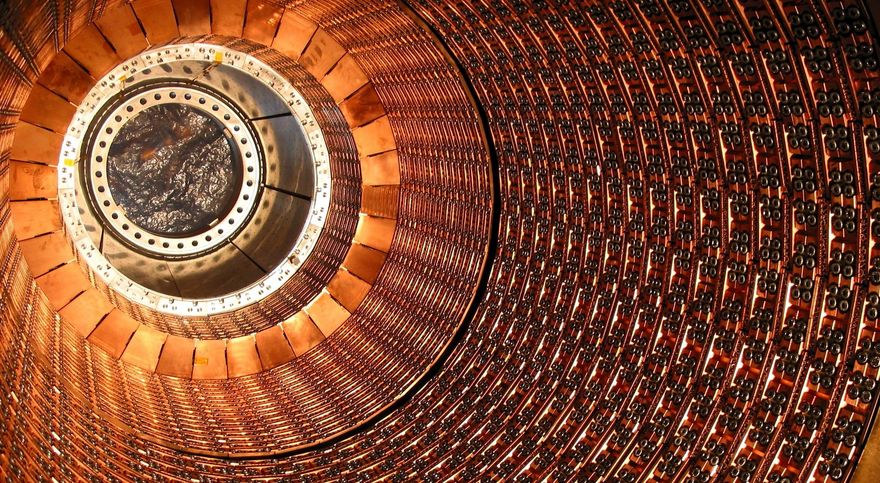The calorimeters in the ATLAS experiment measure the energies of the particles created in the collision of protons. Some particles (electrons, for example) only penetrate the first layers of the calorimeters; others (such as pions) scatter their energy over the entire depth of the calorimeters. Still others (muons and neutrinos, for example) leave behind little or no energy in the calorimeter.
Thus the information from the calorimeters is crucial for identifying the particles produced by the collision. The scientists of the MPP co-developed and took part in construction of the so-called hadronic endcap calorimeter for ATLAS. This part of the calorimeter connects to the first calorimeter layers. It therefore registers mainly particles, such as the pion, that release their energy over the entire depth of the calorimeter.
If such a particle hits the calorimeter, its energy is converted to a "shower" of particles. These new particles ionize a liquid gas – argon – embedded in the calorimeter. This sets free electrons that generate a measurable current.
The hadronic endcap calorimeter covers roughly one-third of the angular field in ATLAS. In the central and forward thirds, which frame the area of the endcap calorimeter, other types of calorimeters take over the task of energy measurement.
How does the calorimeter work?
The hadronic endcap calorimeter is a so-called sampling calorimeter. Here copper plates and liquid argon alternate in regular intervals. The copper layers serve as an absorber and the argon as an emitter.
The actual shower generation takes place in the absorber – high-energy particles are converted into two or more particles with correspondingly less energy. These in turn fan out into many daughter particles. The process stops when the energy of the daughter particles becomes too small to produce further particles.
In the thin argon layers between the copper plates, the daughter particles currently present ionize the argon. The electrons set free in the process are extracted, with the help of a high voltage applied to the argon layer, and are detected as current. The ionization current per daughter particle is constant – and the sum of all currents is a measure of the number of the daughter particles in the shower at a given place. Combine the currents from all of the argon columns, and the result is a mass for the original energy of the particle that hit the detector.
Furthermore, the high-voltage electrodes in the argon columns are finely segmented, so that the position where the energy is deposited in the calorimeter is also measured. The pulses of current are amplified immediately at the edge of the detector – directly in the liquid argon. Special electronics based on gallium-arsenide semiconductors make this possible.
More information on the calorimetry group
Group members
E-mail address: e-mail@mpp.mpg.de
Phone number: +49 89 32354-extension
name
function
e-mail
extension
office
Barillari, Teresa, Dr.
Senior Scientist
teresa.barillari
369
A.1.41
Bethke, Siegfried, Prof. Dr.
Emeritus
siegfried.bethke
381
A.2.05
D'Andrea, Michele
Student
michele.dandrea
511
A.3.03
Greco, Matteo, Dr.
Postdoc
matteo.greco
511
A.3.03
Kado, Marumi, Prof. Dr.
Director
marumi.kado
382
A.2.45
Kiryunin, Andrey, Ph.D.
Senior Scientist
andrey.kiryunin
286
A.0.91
Leis, Ulrich
Engineering
ulrich.leis
550
A.1.67
Menke, Sven, Dr.
Senior Scientist
sven.menke
410
A.1.37
Schacht, Peter, Dr.
Emeritus
peter.schacht
228
A.1.15
Schielke, Anja
Secretary
anja.schielke
299
A.2.47
Wenke, Nina
PhD Student
nina.wenke
767
A.2.19
Group members
Phone number: +49 89 32354-extension
| name | function | extension | office | |
|---|---|---|---|---|
| Barillari, Teresa, Dr. | Senior Scientist | teresa.barillari | 369 | A.1.41 |
| Bethke, Siegfried, Prof. Dr. | Emeritus | siegfried.bethke | 381 | A.2.05 |
| D'Andrea, Michele | Student | michele.dandrea | 511 | A.3.03 |
| Greco, Matteo, Dr. | Postdoc | matteo.greco | 511 | A.3.03 |
| Kado, Marumi, Prof. Dr. | Director | marumi.kado | 382 | A.2.45 |
| Kiryunin, Andrey, Ph.D. | Senior Scientist | andrey.kiryunin | 286 | A.0.91 |
| Leis, Ulrich | Engineering | ulrich.leis | 550 | A.1.67 |
| Menke, Sven, Dr. | Senior Scientist | sven.menke | 410 | A.1.37 |
| Schacht, Peter, Dr. | Emeritus | peter.schacht | 228 | A.1.15 |
| Schielke, Anja | Secretary | anja.schielke | 299 | A.2.47 |
| Wenke, Nina | PhD Student | nina.wenke | 767 | A.2.19 |
Key publications
Topological cell clustering in the ATLAS calorimeters and its performance in LHC Run 1
ATLAS Collaboration, March 2016
arXiv:1603.02934
Upgrade plans for the Hadronic-Endcap Calorimeter of ATLAS for the high luminosity stage of the LHC,
F. Ahmadov et al, July 2015
ATL-LARG-PUB-2015-001
Construction, Assembly and Testing of the ATLAS Hadronic End-cap Calorimeter
D.M. Gingrich et al.
JINST 2 (2007) P05005
Cold electronics for the liquid argon hadronic end-cap calorimeter of ATLAS
J. Ban et al.
NIM A 556 (2006) 158-168
Hadronic calibration of the ATLAS liquid argon end-cap calorimeter in the pseudorapidity region 1.6 < |η| < 1.8 in beam tests
ATLAS Liquid Argon EMEC/HEC Collaboration
Nucl.Instrum.Meth. A531 (2004) 481-514
Key publications
Topological cell clustering in the ATLAS calorimeters and its performance in LHC Run 1
ATLAS Collaboration, March 2016
arXiv:1603.02934
Upgrade plans for the Hadronic-Endcap Calorimeter of ATLAS for the high luminosity stage of the LHC,
F. Ahmadov et al, July 2015
ATL-LARG-PUB-2015-001
Construction, Assembly and Testing of the ATLAS Hadronic End-cap Calorimeter
D.M. Gingrich et al.
JINST 2 (2007) P05005
Cold electronics for the liquid argon hadronic end-cap calorimeter of ATLAS
J. Ban et al.
NIM A 556 (2006) 158-168
Hadronic calibration of the ATLAS liquid argon end-cap calorimeter in the pseudorapidity region 1.6 < |η| < 1.8 in beam tests
ATLAS Liquid Argon EMEC/HEC Collaboration
Nucl.Instrum.Meth. A531 (2004) 481-514
